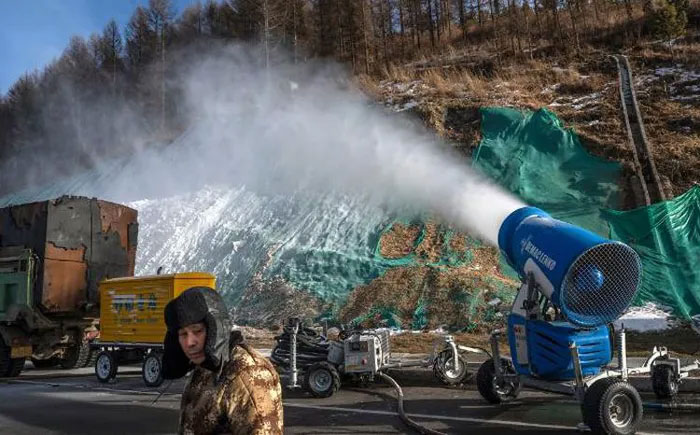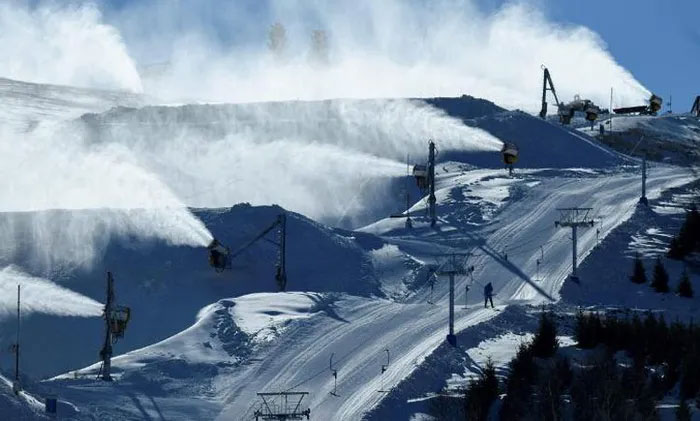The 'dark side' of artificial snow in the Beijing Winter Olympics
Making snow 'consumes' a lot of energy and water. Meanwhile, this year's Beijing Winter Olympics need 1.2 million cubic meters of snow to cover the competition area.
CNN (USA) reported that climate change has forced the Winter Olympics to depend almost 100% on artificial snow. This is a trend for winter sports venues around the world.

Pictured last January is a snow machine in Zhangjiakou, Hebei province, where the Olympic Winter Games in Beijing took place.
According to a recent study, by the end of this century, only one in 21 cities that have hosted the Winter Olympics in the past 50 years still has a climate suitable for winter sports.
As the Earth warms and the weather becomes increasingly erratic, natural snow becomes less reliable for winter sports. Therefore, artificial snow has 'on the throne'.
However, artificial snow is resource-intensive, requiring large amounts of energy and water to be produced in increasingly warmer climates. Athletes also share that winter sports become less safe in the presence of artificial snow.
The average annual snowfall in Yanqing and Zhangjiakou, where some competitions take place, is only about 20cm. From here, the snow generators appear.

Snow machines at the competition in Zhangjiakou city in November 2021.
TechnoAlpin (Italy) has been tasked with producing the necessary amount of snow for outdoor winter sports events in Beijing within the framework of the Olympics.
TechnoAlpin's regional manager Michael Mayr said: 'We are proud to be the only company providing snow generation systems for the Beijing 2022 Winter Olympics.
But there is an important point that makes snow creation in some parts of Beijing difficult, and that is the temperature is not 'forced' to freeze the water. Therefore, Mr. Michael Mayr said: "Clearly we need more energy when the weather is warmer."
Traditionally, snowmaking has relied heavily on snow guns and temperatures at or below freezing. To adapt to warmer temperatures and lower altitudes, a different approach is required. TechnoAlpin announced that it has shipped a full range of snow guns, fan-powered snow generators and cooling towers to Beijing since 2018.
Making snow 'consumes' a lot of energy and water. Meanwhile, this year's Winter Olympics in Beijing need 1.2 million cubic meters of snow to cover the 800,000 square meter competition area. Therefore, the demand for water is enormous. The International Olympic Committee (IOC) estimates that the amount of water needed to make snow at the Olympics is equivalent to drinking water for nearly 100 million people a day.
Meanwhile, athletes are also concerned about competing on artificial snow. French athlete who won bronze at the 2018 Pyeongchang Winter Olympics Clement Parisse shared that artificial snow is often slippery and icy, adding to the challenge.
- How was the winter Olympic ice rink made?
- What is the Winter Olympics?
- Advanced technologies in the Beijing Olympic Games
- PyeongChang Olympic 2018: The number of norovirus infections increased rapidly
- UN: Air pollution threatens Beijing Olympics
- After 30 years, Beijing picked up snow again in April
- Addressing the shortage of snow water in China
- New worms spread through the winter Olympics
- After the Olympics, the fate of billion-dollar works became so disastrous
- Animal Olympics in China
- China raises the alarm level of snow storm risk
- The dark side of the Moon gradually
 Is the magnetic North Pole shift dangerous to humanity?
Is the magnetic North Pole shift dangerous to humanity? Washington legalizes the recycling of human bodies into fertilizer
Washington legalizes the recycling of human bodies into fertilizer Lightning stone - the mysterious guest
Lightning stone - the mysterious guest Stunned by the mysterious sunset, strange appearance
Stunned by the mysterious sunset, strange appearance Mount Fuji in Japan sets a record after 130 years: The end of October and the mountain top still has no snow!
Mount Fuji in Japan sets a record after 130 years: The end of October and the mountain top still has no snow!  Why does the refrigerator freeze and should this layer of snow be removed?
Why does the refrigerator freeze and should this layer of snow be removed?  This crunchy mushroom is known as the 'poor man's bird's nest', helping to control blood sugar while also beautifying the skin
This crunchy mushroom is known as the 'poor man's bird's nest', helping to control blood sugar while also beautifying the skin  The accidental birth of the snow globe more than 120 years ago
The accidental birth of the snow globe more than 120 years ago  Photo series: Korea froze in the Arctic cold wave, white snow and ice covered many cities
Photo series: Korea froze in the Arctic cold wave, white snow and ice covered many cities  The snow melts, the Alps are strongly 'greening'
The snow melts, the Alps are strongly 'greening' 